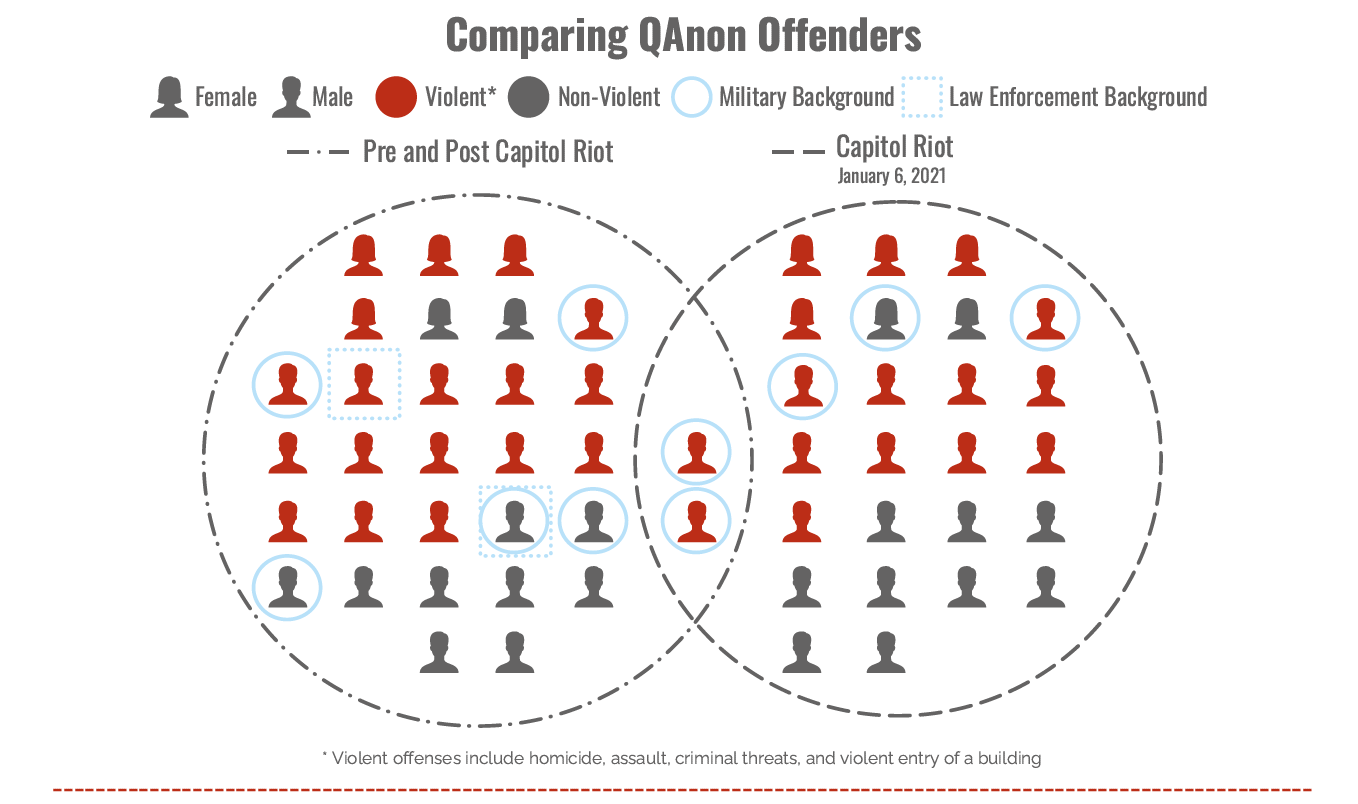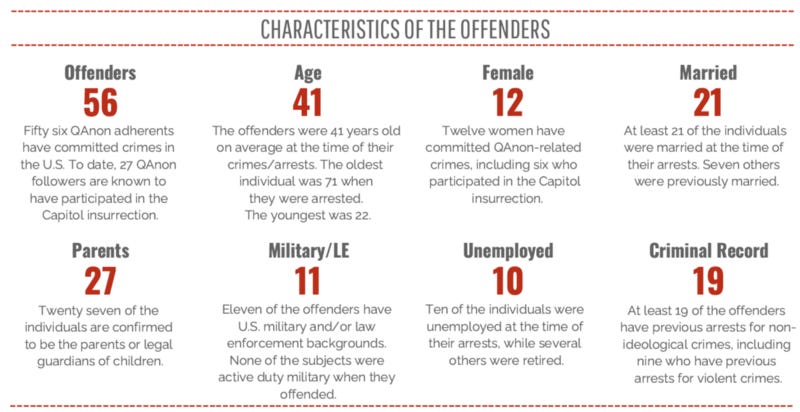New Research Outlines Traits of Qanon Followers Arrested in Relation to Capitol Attack
A new report provides the first rigorous study looking at Q-adherents arrested for crimes related to the Capitol attack
Introduction
Qanon. It’s a catch-all collection of conspiracy beliefs that weaves anti-semitic Nazi propaganda, Christian tropes, and anti-intellectualism. The identity of their prophet, known only as Q, has almost certainly changed. Q is anonymous, hence the name Qanon, so followers and researchers can’t say with certainty who the original or subsequent prophet was.
When the group’s messianic figure, former President Donald Trump, lost the 2020 election, Q-adherents sought to correct this disruption in “the plan.” Journalists uncovered the shockingly rapid radicalization of people arrested for crimes on January 6th. Instead of years, indoctrination happened in months or even weeks, and the collateral damage is massive.
Grief-stricken families seek support by the thousands in online forums where they tell their stories. Whoever they were before is gone:
“My father isn’t my father anymore. He is a political statement. He is bigotry. He is conspiracy theories and violence.”
“My son is so confused about his dad’s brainwashing. He wants to trust his dad but I think at the same time doesn’t.”
“My darling big sister is gone.”
Qualities of Q: The Report
Who were these people, and how did it happen? A new analytical report from START provides some of the first detailed insights into the domestic terrorist group Qanon.
The offenders come from 27 states, including 7 from California, 4 from Arizona, 3 from New Jersey, 3 from New York, 3 from Pennsylvania, and 3 from Virginia.
— START, 2021
Profiles like these can help us identify who may be at risk, find ways to prevent radicalization, and help the public identify people in their community that may be drawn into these groups. It can help us understand the mechanisms that pull people from reality into the dark world of extremist hate.
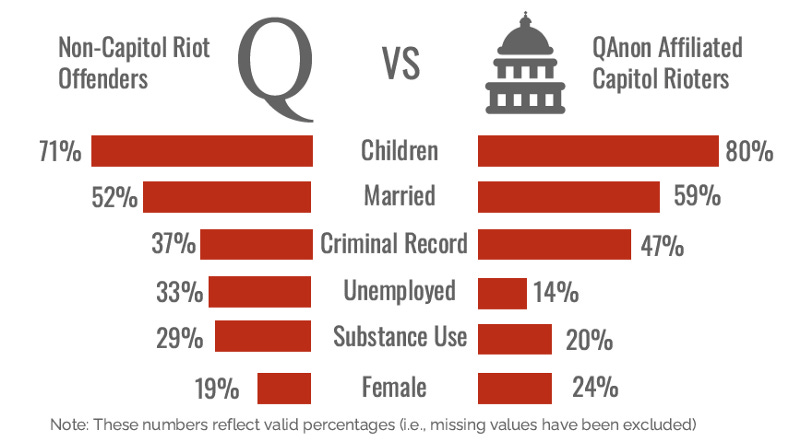
Looking at Qanon arrests not related to Jan 6th shows a strikingly similar profile. Over 40% of the offenders who committed crimes related to Jan 6th had experienced trauma, after which they radicalized. That number jumps to 83% for female offenders.
Tragically, abuse may have created a vulnerability where people with traumatic histories lept at the chance to fight against abuse. Women disproportionately suffer PTSD following trauma. It’s unclear if the trauma itself, developing PTSD, or something else, makes them more vulnerable.
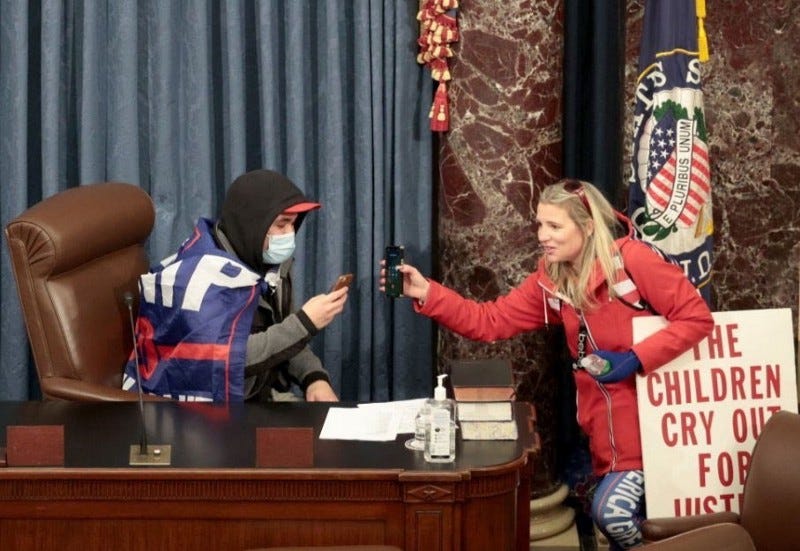
Qanon often grabs new followers with claims that it fights child exploitation and sex trafficking. To date, the group cannot point to a single child saved or trafficking network uncovered. Conspiracies drive sex-trafficking rumors that have gotten in the way of real organizations that fight human trafficking.
Director of the US National Human Trafficking Hotline Megan Cutter discussed how Qanon furthers misconceptions about how people end up in human trafficking — a majority are sold or live in captivity thanks to a relative or guardian. Misinforming the public means that real activists can make less progress.
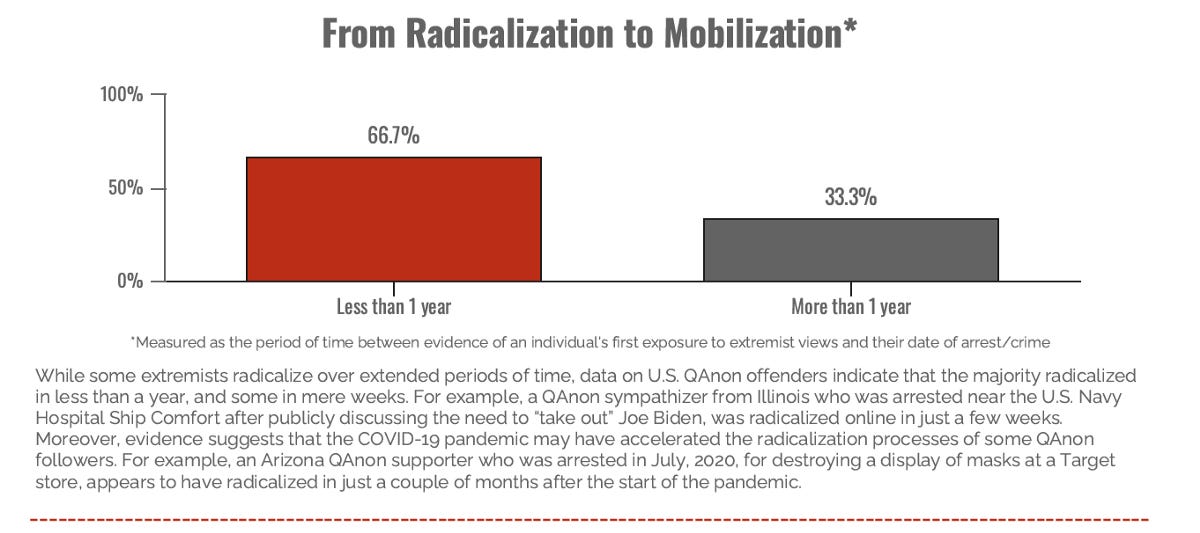
The pace of radicalization with Qanon is part of the reason it poses such a threat. Exactly 2/3 of Q-followers arrested at the capitol had radicalized in less than a year, with some cases taking only a few weeks. It used to take years to indoctrinate an individual to the degree that those who attacked the Capitol had been. Another factor expediting radicalization may have been that so many of those arrested were already members of other extremist groups or held other conspiracy beliefs.
Qanon has become a nexus where existing extremists expand their conspiracy beliefs. Those who were not extremists before getting pipelined into extremism by algorithms that recommend groups that overlap with yoga, “crunchy” parenting, and anti-vaccine groups. Shelter-in-place orders isolated people and led them to spend much more time online. Extremist groups exploited the pandemic to recruit and expanded membership using tactics previously used by ISIS to recruit.
Major on-ramps into extremism
On-ramps are groups that prime people, intentionally or unintentionally, to be more receptive to Qanon ideology. Any online community can introduce and normalize conspiracy thinking, but there are especially noteworthy groups that have fast-tracked people into conspiracy beliefs:
Wellness community: Yoga, Pseudoscience, Anti-vaccine groups
“Pastel” Qanon: the pastel style of propaganda mimics the soft design of mommy blogs and crafty websites. These have been highly successful. Aesthetics are used to draw people into White Supremacy movements as well.

Mobilized moms/dads: parents who want to save children and who are primarily motivated to join by this desire
Militias: paramilitary organizations that fear government and see themselves as duty-bound to protect their freedom.
Christian Nationalists: An authoritarian strain of Christianity has spread rapidly in Evangelical and Catholic groups in the US. These groups have been the subject of dark ads and data harvesting that allows bad actors to target them with influence operations.
A disproportionate number of Qanon followers arrested had a history of mental illness — especially conditions not easily managed without treatment like PTSD, bipolar disorder, and Munchausen syndrome by proxy.

Mental illness doesn’t cause a person to become violent, but it may make them more vulnerable to people who want to influence them.
Psychiatric conditions often exist alongside other factors that increase the risk of becoming violent, like substance abuse. Job loss, early exposure to violence, and poverty all increase the risk for violence, and they may also increase the risk for mental illness.
That could make it appear like mental illness was the driver of violence when another variable affected mental health and whether someone became violent. Looking at people with schizophrenia or bipolar disorder, those with substance used disorders are several times more violent. At the same time, those without addiction become violent at a rate similar to that of the general public.
Public discussion about violent acts like gun massacres often falls back on misguided beliefs about mental illness. People with weak support systems, financial instability, a history of trauma, addiction, abuse, or serious mental illness may be more easily influenced by unethical practices.
Critically, that a high percentage of people arrested had a history of mental illness does not show that mental illness caused the violence.
Extremist ideology turned people violent; mental illness may have made them more vulnerable to undue influence, just as poverty and joblessness can. Risk factors specific to far-right radicalization are county-level poverty and low rates of unemployment.
Conflating mental illness with what is driving homegrown extremism has allowed decades of unproductive discussion and proliferation of extremism in the US. Parties that have a vested interest in keeping guns as unrestricted as possible, like the NRA, deflect away from the evidence, suppress research, sow disinformation, promote fears that guns will be taken from people, and offer various explanations without evidence.



